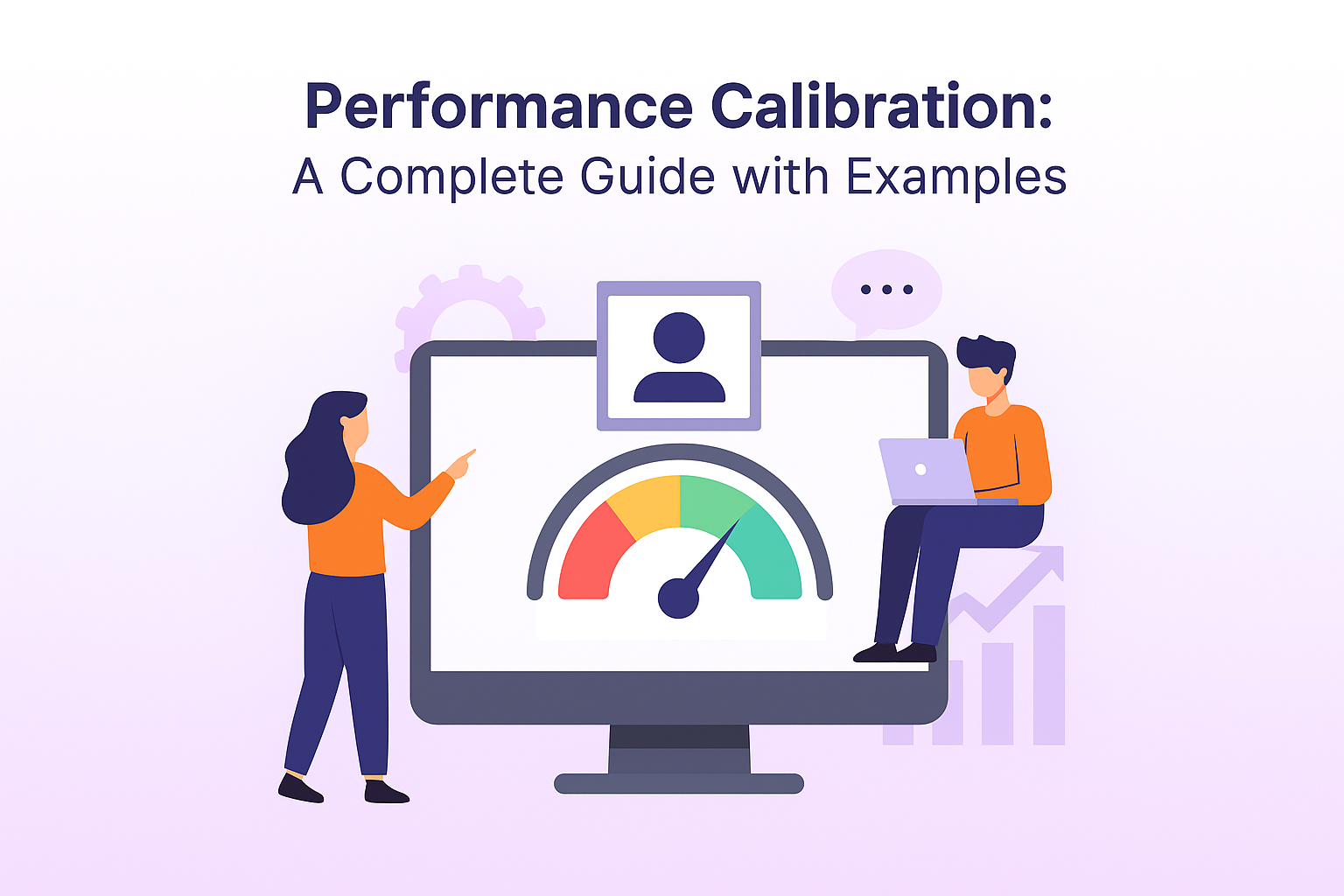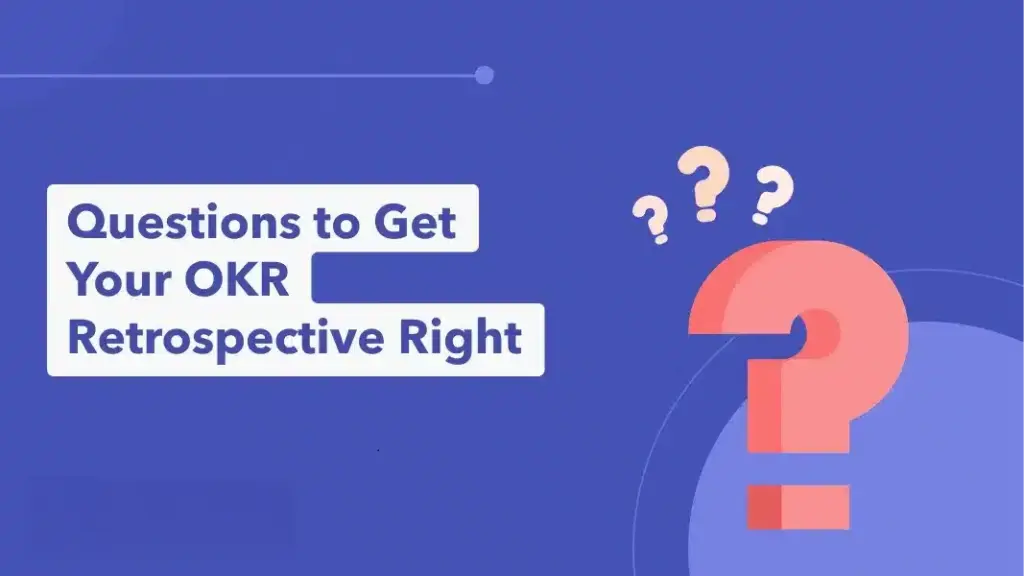TL;DR
Performance reviews without calibration can feel like the Wild West: one manager’s too generous, another’s too strict, and employees end up confused and frustrated. Performance calibration fixes that by aligning managers on a consistent set of standards, cutting through bias, and making sure promotions and raises are based on actual performance not favoritism.
In this guide, you’ll learn what calibration means, how it works, why it matters, examples of calibration in action, best practices to get it right, and the tools HR leaders use in 2026 to make the process less painful and more effective.
Performance reviews, in theory, should spotlight what folks do well, nudge them to improve, and keep everyone rowing in the same direction. But let’s be real without some kind of system, reviews can turn into a total mess. One boss might hand out gold stars like candy, while another’s channeling Simon Cowell, and suddenly, two people doing basically the same job get wildly different marks. Makes no sense, right?
Enter performance calibration. Fast forward to 2026 companies are finally waking up and realizing calibration isn’t just some checkbox on HR’s to-do list. It’s the backbone of fairness. It keeps everyone honest, evens out the scoring, and honestly, just stops managers from going rogue.
With calibration in play, people know the process isn’t a black box, folks start trusting the system, and leaders can actually make smart calls about who to reward or develop no more rolling the dice.
What Is Calibration in Performance Management?
Alright, let’s break down this “calibration” thing in performance management. Basically, it’s when bosses get together and compare notes to make sure they’re not all over the place with their ratings. You know how some managers are way too nice, handing out top marks like candy, while others act like you need to walk on water just to get a “good job”? Yeah, calibration is supposed to fix that mess.
Here’s the deal: the idea is to even out those wild differences, so your review actually matches your work—not just your boss’s mood or personal style.
Why bother? Because stuff like promotions and raises should be based on actual performance, not whether your manager had their coffee that morning. If there’s no calibration, some folks coast to the top while others get totally shafted, and nobody trusts the system. So yeah, calibration’s just making sure everyone’s playing by the same rulebook. No more “favorite child” nonsense.
Why Does Performance Calibration Matters?
Alright, let’s ditch the corporate jargon for a second. Performance management calibration isn’t just another HR buzzword, it actually matters. Here’s the deal: it keeps things fair. You don’t want your raise or promotion riding on whether your boss is in a good mood or just really likes Steve from accounting, right? Calibration steps in to level the playing field, cutting through favoritism and those sneaky biases that everyone pretends don’t exist.
Plus, it means everyone’s playing by the same rules. Whether you’re in marketing or IT, your work gets measured with the same yardstick. People notice that sort of thing. It builds trust, keeps folks from eye-rolling at review season, and yeah, makes them stick around longer. In short: calibration makes sure you’re recognized for what you actually do not just because you got lucky with your manager.
Performance Review Calibration vs. Traditional Reviews
Let’s be real old-school performance reviews are kinda all over the place. It’s basically one manager’s gut feeling versus another’s, so yeah, consistency? Not really a thing. You might crush your goals and get a “meh” rating just ’cause your boss is stingy with praise, while someone else gets gold stars for the same work. Super fair, right?
Now, calibration reviews shake things up. Instead of one person calling all the shots, you’ve got a bunch of managers (plus HR poking their heads in) hashing it out together. They compare notes, argue a bit, and make sure everyone’s on the same page with what “good” actually means across the company.
Here’s the difference: Let’s say two folks do basically the same job. Without calibration, one gets “exceeds expectations” and the other just “meets,” for no real reason. But when you run these ratings through calibration, suddenly the playing field’s level. People actually get recognized fairly. It’s harder for bias to sneak in, and nobody can say the system’s rigged. Boom, way more legit.
How Employee Calibration Works in Practice?
Let’s be real, employee calibration isn’t rocket science, but it sure isn’t just guesswork either. Here’s how it usually goes down:
- First, managers toss in their two cents with those initial ratings. Then HR swoops in, crunches the numbers, and whips up some fancy benchmarks.
- Next, you’ve got everyone, managers and HR packed into a meeting room (probably with too much coffee), debating and tweaking those ratings.
- By the end, they’ve hashed it out and landed on final scores, which eventually trickled down to the employees.
During these sessions? Oh, it gets spicy. People go over the whole spread of ratings, call out the top dogs and the folks who need a little pep talk, and then mess with the scores till they fit whatever “company standards” are supposed to be that year. Someone scribbles down the reasons, so nobody forgets what went down when review season rolls around again.
Bottom line: you end up with results that actually make sense or at least, nobody can complain too much.
| Make Performance Reviews Fair with Peoplebox.ai Calibration doesn’t have to be messy. Peoplebox.ai brings fairness and consistency with: ✅ AI-powered insights to spot bias and align ratings ✅ Automated workflows that save time in calibration sessions ✅ Dashboards unifying reviews, OKRs, and feedback ✅ Seamless integrations with Slack, Teams, and your HRIS With Peoplebox.ai, calibration becomes simple, transparent, and trusted across your organization. 👉 Book a Demo today. |
Performance Calibration Examples
Alright, let’s make this sound like an actual person’s brain at work:
- Okay, so picture this: one boss thinks their star employee is just crushing it gives ‘em an “outstanding.” But then, everyone else? They’re like, “Eh, more like ‘exceeds expectations’.” So, the calibration squad steps in and kinda evens things out, so nobody’s inflating egos or playing favorites across the board.
- Now, for the middle-of-the-pack folks. Maybe someone gets slapped with a “below expectations” at first. But when they stack that person up next to other people doing the same gig, it turns out they’re actually right where they should be. Boom bumped up to “meets expectations.” Not bad.
- And then you’ve got the classic “meh” situation. Somebody’s chilling with an “average” rating, but when you zoom out and see everyone else at that level is actually getting dinged a bit lower, guess what? That person’s score drops. Ouch, but hey, that’s calibration for you.
Basically, all this back-and-forth stops managers from handing out gold stars like Halloween candy or, on the flip side, tanking someone’s rating just because. Keeps things a little more fair, you know?
Best Practices for Performance Management Calibration
Alright, let’s cut through the corporate mumbo-jumbo for a sec. Want performance calibration that actually works? Here’s how you don’t mess it up:
- First off, get real about what counts as “crushing it” or “dropping the ball.” None of this vague HR lingo spells it out so nobody’s left guessing.
- Then, don’t just vibe your way through reviews. Bring receipts. Numbers, goals, actual results if you can’t measure it, did it even happen?
- Also, managers need a clue. Seriously, give them some training so they can spot their own bias and know how to judge fairly. Otherwise, it’s just the popularity of the Olympics.
- Oh, and keep records. If you tweak someone’s rating, jot down why. Future-you will thank you, trust me.
Bottom line? When the rules aren’t a secret handshake, the whole process gets way less sketchy and way more fair.
Challenges in Performance Review Calibrations (and How to Solve Them)
Oh, calibration. It’s one of those necessary evils, isn’t it?
- Here’s the thing: this whole process can be a real time-suck. Like, you blink and suddenly you’ve lost half your day knee-deep in spreadsheets. Honestly, just grab some decent software to handle the boring data bits. Major sanity-saver.
- Now, managers? Some of them absolutely hate it when their ratings get tweaked. They get all defensive, like you’ve insulted their firstborn. Best bet? Give them a crash course in why fairness actually matters, maybe even toss in a donut or two for good measure.
- And let’s not even start with the obsession over numbers. People aren’t robots (well, most of us), so don’t just rely on cold, hard stats. Mix in some real feedback, actual words, you know?
- Big companies have it rough, too. Scaling this stuff is like herding caffeinated cats. But hey, there are AI tools now that can do a lot of the heavy lifting. Just let the machines sweat the details so you can go grab a coffee.
Tools and Systems That Support Calibration Performance Reviews
So, here’s the deal—2026 isn’t messing around when it comes to calibration.
- Tech is basically rolling out the red carpet and making everyone’s lives way less painful. You’ve got software doing the heavy lifting: scooping up data, calling people out on sketchy ratings, and keeping convos a little less wild west, a little more fair.
- Then there’s AI and analytics. Those guys are like the office detectives. They’ll sniff out bias, flag people who might be eyeing the exit, and even nudge folks if their ratings are looking a little bad. Creepy? Maybe. Useful? Absolutely.
- Oh, and now everything’s mashed together calibration, feedback, goals, all living in one big digital soup. So you actually get a real sense of how people are doing, not just some random score once a year. Long story short: these tools are making calibration meetings less of a headache and helping make things fair… or at least, fair-ish.
Final Thoughts
Let’s be real performance review calibration used to be that annoying, optional meeting nobody wanted to sit through. Now? You can’t really skip it if you actually care about fairness or trust at work. It’s not just about smoothing out those wild manager ratings or pretending “everyone’s above average.” Calibration’s what stops the whole thing from turning into some Hunger Games of office politics. Folks want to know the process isn’t just a coin flip, right?
Honestly, the future’s looking pretty wild. We’re talking AI tools, instant feedback, all that jazzy tech. Calibration won’t just fix screw-ups, it’ll actually push people to grow, help companies spot who’s really crushing it, and make sure promotions aren’t handed out just because “Bob’s a nice guy.”
Bottom line? Calibration isn’t just a spreadsheet exercise. It’s about treating people right. Sure, it’s a pain sometimes, but when you nail it, the whole review thing stops feeling like a pointless ritual and actually helps folks get better. That’s the good stuff.
Frequently Asked Questions(FAQs)
What is performance calibration?
Performance calibration is the process where managers and HR align on performance ratings to ensure fairness and consistency across the company. It prevents inflated or unfair scores based on individual manager bias.
Why is performance calibration important?
It ensures employees are evaluated on their actual contributions, not manager preferences or mood. Calibration builds trust in the review process and creates a level playing field for promotions, raises, and development opportunities.
How does performance calibration work?
Managers submit initial ratings, HR benchmarks the data, and then calibration meetings are held where leaders debate, adjust, and align ratings before finalizing reviews.
What are some examples of calibration in performance reviews?
- Downgrading inflated ratings when peers don’t align.
- Adjusting “below expectations” scores if an employee is performing at the team average.
- Leveling differences across departments so similar roles are judged equally.
How is calibration different from traditional performance reviews?
Traditional reviews are manager-driven and often inconsistent, while calibrated reviews involve multiple managers and HR aligning on shared standards, ensuring fairness across the board.
What challenges come with performance calibration?
Common issues include time-consuming meetings, manager defensiveness when ratings are adjusted, and over-reliance on numbers. Modern HR software and AI tools help smooth these challenges.
What tools support calibration reviews in 2026?
Platforms like Peoplebox.ai, Lattice, and Betterworks use AI and analytics to automate benchmarks, flag bias, and integrate calibration with feedback and OKRs—making calibration sessions faster and more data-driven.






